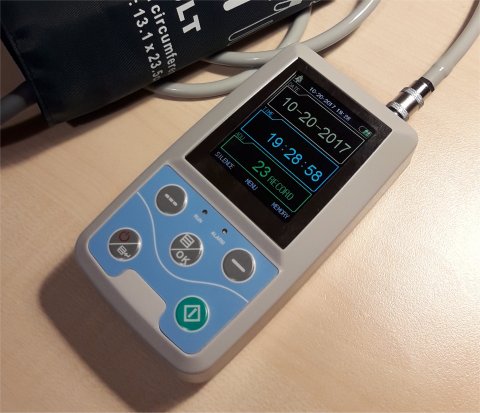

Home


|
File Format of the ABPM50 24h Blood Pressure Measurement InstrumentNote: Unfortunately this is outdated. The manufacturer seems to have changed the file format. If your .awp-file contains the lines "FileVersion_Main=2" and "FileVersion_Sub=0", this macro should work: ReadAbpm50FileNewFF.txt. Thanks, Christoph, for the adaptions! When taking blood pressure measurements, there are two things that annoyed me again and again:
Therefore kudos to the Contec, that
shows with their ABPM50 how long-term periodic measurements can be made by a relatively affordable price:  I do not want to write long about the instrument itself, there are lots of reviews in the internet. My negative points are quickly listed: The highlighting of the active menu point is very hard to see (white frame changes to yellow). The seconds point is the PC software, it is not really beautiful, some rework could not harm, many cosmetic points to complain about. But what is really bad: There seems to be no export in a useful data format. The measurement values are saved with an extension ".awp". I have analyzed the data format at least partially by some reverse-engineering. I also wrote an Excel-Macro that allows the import into Excel. Because I believe that other users could be interested too I decided to present them here. The .awp files are luckily text files that can be viewed with an editor such as notepad. It can be seen easily that the measurements are stored within lines by using hexadecimal digits. After looking deeper I was able to guess the secrets, kudos to the software developer who has done that, it is pragmatic and simple. According to my understanding the lines are composed as follows:
Measurement Number
| Systolic Pressure in mmHg (2-digit Hexadecimal Number), 74(hex) = 116(dez)
| | Diastolic Pressure, 43(hex) = 67(dez)
| | | Pulse Rat in Beats per Minute, 44(hex) = 68(dez)
| | | | Average Artery Pressure, 52(hex) = 82(dez)
| | | | | Minutes since Measurement Start (4-digit Hexadecimal Number), 04C4(hex) = 1220(dez)
| | | | | |
| ssddppaammmm??
149=00007443445204C4030000000
148=000072433A4F04BF030000000
147=0000784B3B5904BA030000000
146=00007947395504B5030000000
The part marked with "??" remains unresolved. Maybe these are marker bits for measurements that have been edited with the PC program. The information about the minutes since measurement start requires the true starting time to calculate the absolute time and date. This information can be found in the following lines:
MinBegin=40
HourBegin=14
DayBegin=25
MonthBegin=7
YearBegin=2008
Visual Basic, the language used for Excel-Macros, offers all required functions to import the data: Opening files, scanning character strings, cut them in fragments, converting hexadecimal digits too. Here is a simple Excel-Macro, which reads .awp-Files and displays the contained measurement data in a table with the thw following columns (MAP = Mean Artery Pressure, HR = Heart Pulse Rate):
Number Date/Time Sys Dia MAP HR
The macro can be simply entered by copy&paste from this web-page into the Visual-Basic editor of Excel:
For sure a lot of things can be improved, such as an automatic creation of a diagram for example. But here I tried to present only a basic starting point that can be extended by everyone on his own. Oktober 2017 |
| © 2025 Alexander Mumm |